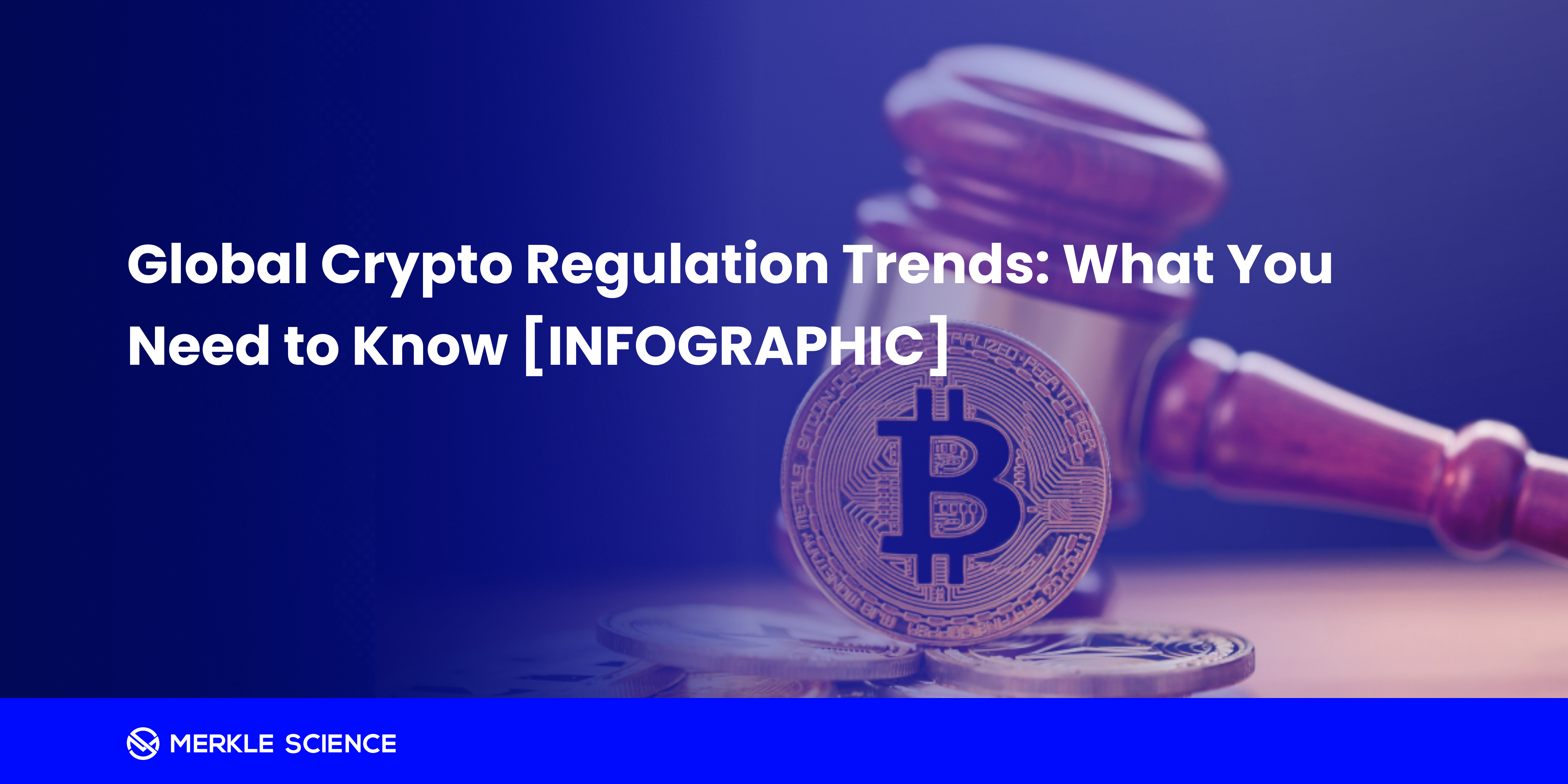Global Crypto Regulation Trends: What You Need to Know [INFOGRAPHIC]

Merkle Science

As cryptocurrencies gain mainstream acceptance, governments worldwide face the challenge of creating regulatory frameworks that address the unique characteristics of digital assets while fostering innovation. From outright bans to the adoption of comprehensive frameworks, the approaches vary widely, reflecting differing economic priorities, risk appetites, and levels of adoption. In this blog, we delve into the global landscape of crypto regulation, examining key trends, regional strategies, and the significant shift in the European Union’s regulatory philosophy.
To provide a visual summary of the points discussed, Merkle Science has created an infographic that highlights the key regulatory approaches taken globally. Be sure to scroll down to see it embedded in this blog.
A World of Contrasts: Four Main Approaches to Crypto Regulation
Governments across the globe have adopted one of four primary strategies in addressing crypto regulation. Each approach reflects unique concerns and priorities:
1. Outright Bans
Some countries, like Bolivia, Bangladesh, and Kuwait, have opted for a strict prohibition on cryptocurrencies. This approach typically stems from concerns over financial instability, fraud, and money laundering. While bans may appear decisive, they often drive crypto activities underground, making regulation and oversight even more challenging.
2. Transitional Frameworks
Countries such as China, Nigeria, and India represent an evolving stance. Initially restrictive, they are slowly moving toward regulatory frameworks that balance oversight with opportunities for innovation. This transitional approach suggests a recognition of crypto's potential to contribute to economic growth, particularly in areas like cross-border payments and decentralized finance (DeFi).
3. Comprehensive Regulatory Frameworks
Nations like the United Kingdom, Singapore, and Japan have established dedicated regulatory frameworks for crypto. By clearly defining rules and expectations, these jurisdictions create a safer environment for investors and foster trust in digital assets. These countries often lead the way in setting standards that others might follow.
4. The Wait-and-See Approach
Countries such as Vietnam and Costa Rica have adopted a cautious stance, monitoring the market and its developments before formalizing regulations. This allows them to learn from the successes and failures of others but risks leaving them unprepared for rapid market shifts.
The European Union’s Evolution: From AMLD to MiCAR
Perhaps one of the most significant developments in global crypto regulation is the European Union’s shift from the Anti-Money Laundering Directive (AMLD) to the Markets in Crypto-Assets Regulation (MiCAR). The transition reflects a broader recognition of the need for a unified, comprehensive approach to regulating digital assets across the EU.
Under AMLD, the focus was narrow—primarily anti-money laundering and counter-terrorism financing measures. MiCAR, however, introduces sweeping changes aimed at investor protection, market stability, and the regulation of stablecoins. It harmonizes crypto regulations across the EU, eliminating the fragmented landscape that previously posed challenges for businesses and investors alike.
|
Feature |
AMLD |
MiCAR |
|
Focus |
AML and counter-terrorism financing |
Comprehensive crypto asset regulation |
|
Market Impact |
Fragmented regulations across EU members |
Unified framework across all member states |
|
Investor Protection |
Limited |
Stronger measures for transparency |
|
Stablecoins |
No specific rules |
Specific provisions for stablecoins |
MiCAR’s introduction positions the EU as a global leader in crypto regulation, offering a template for other regions aiming to regulate without stifling innovation.
Key Trends Shaping Crypto Regulation Globally
Growing Adoption
As crypto assets become more widely adopted, regulators are under pressure to create frameworks that address retail, institutional, and governmental needs. Countries like the UAE and Singapore are setting benchmarks with licensing frameworks that cover not only AML compliance but also operational standards.
Investor Protection
With incidents like exchange collapses and token fraud making headlines, investor protection has become a top priority. Regulatory frameworks increasingly emphasize transparency, risk disclosure, and stronger compliance measures to safeguard market participants.
Regional Collaboration
The introduction of MiCAR in the EU could inspire similar collaborative efforts in regions like Asia and Latin America, where fragmented regulations currently prevail. Coordinated strategies could reduce regulatory arbitrage and create a more stable environment for crypto businesses.
The Role of Merkle Science in Navigating Crypto Regulation
As regulatory landscapes evolve, businesses must remain agile to stay compliant while exploring opportunities in the crypto space. Merkle Science’s suite of tools empowers organizations to monitor transactions, ensure AML compliance, and stay ahead of regulatory changes. Our mission is to provide actionable intelligence and the tools needed to build trust and transparency in the crypto ecosystem.
Explore the Infographic
The infographic below, created by Merkle Science, offers a concise visual overview of the global approaches to crypto regulation discussed in this blog. Use it as a reference to better understand the diverse strategies shaping the future of digital assets.

Final Thoughts
Crypto regulation is no longer a question of "if" but "how." While the approaches vary, the global trend leans toward creating structured, comprehensive frameworks that address risks without stifling innovation. For businesses, staying informed and prepared is essential. Whether you're navigating new compliance requirements or exploring growth opportunities in regulated markets, Merkle Science is here to help.
Ready to stay ahead of crypto regulations? Book a demo with Merkle Science today and discover how we can support your compliance journey.


